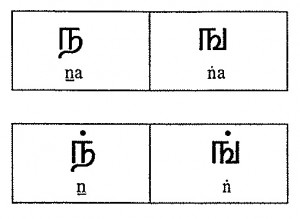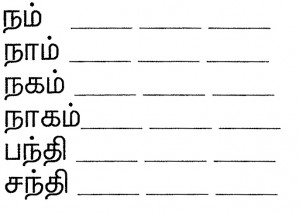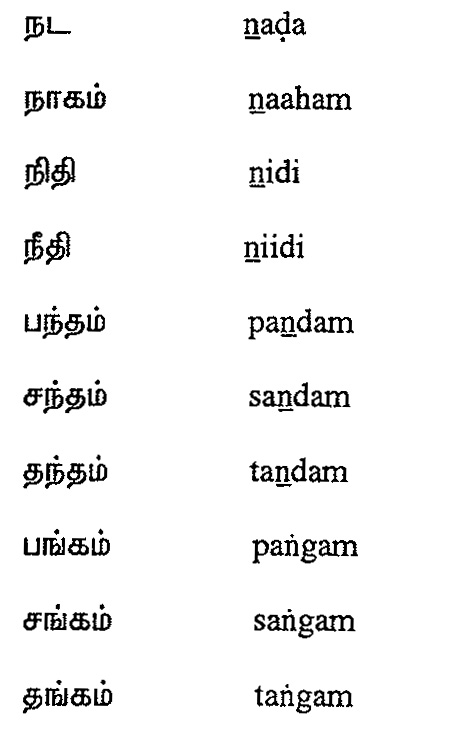Frame 5

When the tip of the tongue is raised against the upper teeth (n) is produced. The soft palate is lowered and the air escapes freely through the nasal cavity. There is vibration in the vocal cords. It is to be recollected here that the sound value of ![]() (ṭ) seen in Frame 1. The movements of the speech organs are the same as that of (d), the voiced one except that the air stream passes through the nasal cavity in the case of
(ṭ) seen in Frame 1. The movements of the speech organs are the same as that of (d), the voiced one except that the air stream passes through the nasal cavity in the case of ![]() (n). This is described as voiced dental nasal. It occurs medially as in the words,
(n). This is described as voiced dental nasal. It occurs medially as in the words, ![]() etc. and Elsewhere it is pronounced as alveolar as in the English words name, invitation etc. and in Tamil words like
etc. and Elsewhere it is pronounced as alveolar as in the English words name, invitation etc. and in Tamil words like ![]() ,
, ![]() etc.
etc.
Observe how the letter for the sound (na) is written and copy three times.

The letter ![]() may also be written, deleting the extended curve line at the end.
may also be written, deleting the extended curve line at the end.
Observe how the secondary symbols for the vowels ![]() ,
, ![]() and
and ![]() are added to
are added to ![]() .
.
The letters ![]() ,
, ![]() ,
, ![]() ,
, ![]() cannot occur in the middle or end of a word. However,
cannot occur in the middle or end of a word. However, ![]() can occur medially before
can occur medially before ![]() ,
, ![]() ,
, ![]() etc.
etc.
This can be seen in the words, ![]() ‘that’,
‘that’, ![]() ‘this’ etc.
‘this’ etc.
Read the words and write them three times each.

![]() (na): In its production the air stream is blocked by the back of the tongue while it is in firm contact with the soft palate as in the production of (g). The soft palate is lowered and the air passes through the nasal passage. The vocal cords are vibrated. This is described as a voiced velar nasal. It occurs only in the medial position with its corresponding voiced velar stop,
(na): In its production the air stream is blocked by the back of the tongue while it is in firm contact with the soft palate as in the production of (g). The soft palate is lowered and the air passes through the nasal passage. The vocal cords are vibrated. This is described as a voiced velar nasal. It occurs only in the medial position with its corresponding voiced velar stop, ![]() (k).
(k).
Observe how letter for ![]() (ṅa) is written and write it four times. Your letter should be like the one given at extreme right.
(ṅa) is written and write it four times. Your letter should be like the one given at extreme right.
![]() ______ ______ ______ ______
______ ______ ______ ______ ![]()
Compare the letter for (na) with the letter for (ṅa). Write them four times each:

Secondary symbols for vowels ![]() ,
, ![]() and
and ![]() are added to the nasal consonant
are added to the nasal consonant ![]() .
.

It is already pointed out that the letter ![]() usually occurs only in its pure consonantal form, namely
usually occurs only in its pure consonantal form, namely ![]() , immediately followed by letters of
, immediately followed by letters of ![]() series, such as
series, such as![]() ,
,![]() ,
, ![]() , etc. That is,
, etc. That is, ![]() series letters after
series letters after ![]() are pronounced as soft sounds (voiced sounds) like, ga, gaa, gi etc.
are pronounced as soft sounds (voiced sounds) like, ga, gaa, gi etc.
Read the words aloud and write them three times each.

Read the following words.

